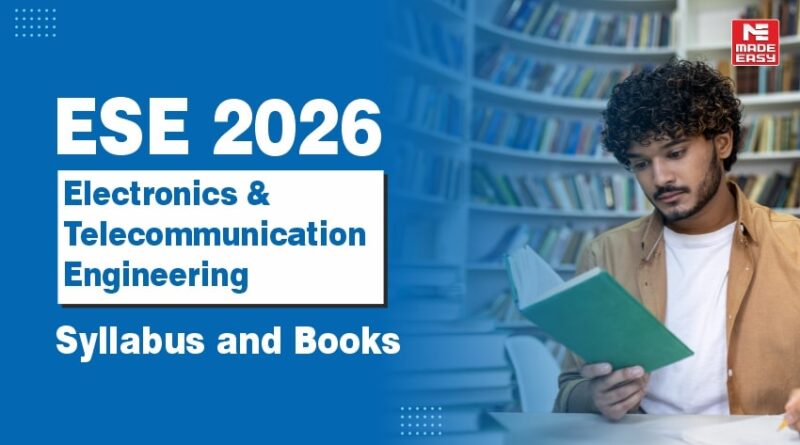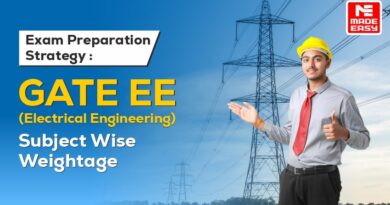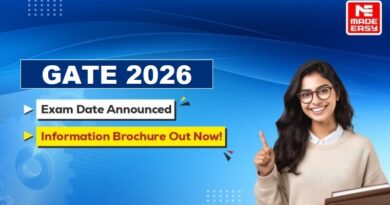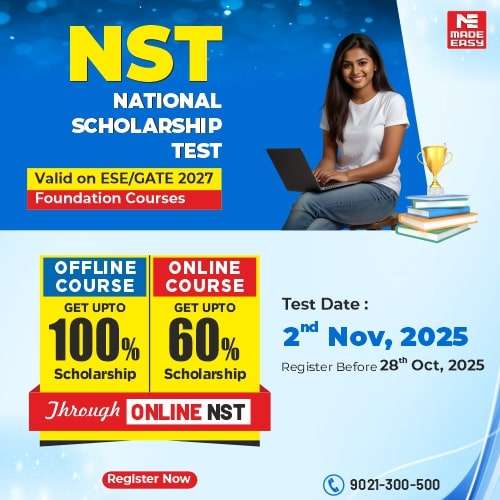ESE 2026 Electronics & Telecommunication Engineering Syllabus and Books
The Engineering Services Examination also referred to as ESE, is one of the major examinations conducted by UPSC. Each year, thousands of aspirants appear for this exam and clear the subsequent stages of the exam, i.e., prelims, mains, and the personal interview round, to serve in various departments of the Government of India as designated officials in the respective government departments.
What is ESE Electronics and Telecommunication Engineering?
Electronics and Telecommunication Engineering is one of the top engineering streams that forms part of the Engineering Services Examination (ESE). This is one of the most challenging exams for engineering students in the government sector, especially for engineering graduates and students belonging to Electronics and Telecommunication Engineering background. The selected candidates receive selection at some of the top government organizations in the railways, naval, telecom, and power engineering sectors for the Grade A and B posts.
What is the ESE Electronics and Telecommunication Engineering Syllabus 2026?
The ESE 2026 Syllabus associated with the Electronics and Telecommunication Engineering subject is as follows:
ESE Syllabus Preliminary Stage-I Examination: Electronics and Telecommunication Engineering (E&T)
The standard of the paper in General Studies and Engineering Aptitude (Preliminary Stage-I Examination) will be as may be expected of an engineering or science graduate. The standard of papers in other subjects will approximately be that of an engineering degree examination at an Indian university. There will be no practical examination in any of the subjects. One must keep the following points in mind concerning General Studies and Engineering Aptitude (Preliminary Examination/Stage-I, Paper-I, Objective Type, Common to All Candidates):
- Current issues of National and International importance, relating to Social, Economic, and Industrial Development.
- Engineering Aptitude covering Logical Reasoning and Analytical Ability.
- Engineering Mathematics
- Numerical Analysis
- General Principles of Design, Drawing
- Importance of Safety
- Standards and Quality practices in Production, Construction, Maintenance, and Services.
- Basics of Energy and Environment: Conservation, Environmental Pollution and Degradation, Climate Change, Environmental Impact Assessment.
- Basics of Project Management
- Basics of Material Science and Engineering
- Information and Communication Technologies (ICT) based tools and their applications in Engineering such as Networking, E-Governance, and technology-based education.
- Ethics and Values in the engineering profession.
ESE 2026 aspirants must remember these points associated with the ESE Syllabus for Electronics and Telecommunication Engineering.
*Note: The paper in General Studies and Engineering Aptitude will include knowledge of relevant topics, as may be expected from an engineering graduate, without special study. Questions from all the 10 topics mentioned above shall be set. The marks for each of the topics in both papers range from 5% to 15% of the total marks in the paper.
The contents of the syllabus for both papers are together for the preliminary examination (Stage‐I) and separately for the mains (Stage‐II) examination. The preliminary examination associated with the ESE 2026 syllabus comprises mainly the objective type Paper-II. The next part of the ESE 2026, i.e., the Mains Examination, comprises the conventional types Paper-I and Paper-II.
ESE Mains Exam Electronics and Telecommunication Syllabus (PAPER – I)
1. Basic Electronics Engineering:
Basics of semiconductors; Diode/Transistor basics and characteristics; Diodes for different uses; Junction & Field Effect Transistors (BJTs, JFETs, MOSFETs); Transistor amplifiers of different types, oscillators and other circuits; Basics of Integrated Circuits (ICs); Bipolar, MOS and CMOS ICs; Basics of linear ICs, operational amplifiers and their applications- linear/non-linear; Optical sources/detectors; Basics of Opto electronics and its applications.
2. Basic Electrical Engineering:
DC circuits-Ohm’s & Kirchoff’s laws, mesh and nodal analysis, circuit theorems; Electro-magnetism, Faraday’s & Lenz’s laws, induced EMF and its uses; Single-phase AC circuits; Transformers, efficiency; Basics-DC machines, induction machines, and synchronous machines; Electrical power sources- basics: hydroelectric, thermal, nuclear, wind, solar; Basics of batteries and their uses.
3. Materials Science:
Electrical Engineering materials; Crystal structure & defects; Ceramic materials-structures, composites, processing and uses; Insulating laminates for electronics, structures, properties and uses; Magnetic materials, basics, classification, ferrites, ferro/para-magnetic materials and components; Nano materials-basics, preparation, purification, sintering, nano particles and uses; Nano-optical/magnetic/electronic materials and uses; Superconductivity, uses.
4. Electronic Measurements and Instrumentation:
Principles of measurement, accuracy, precision and standards; Analog and Digital systems for measurement, measuring instruments for different applications; Static/dynamic characteristics of measurement systems, errors, statistical analysis and curve fitting; Measurement systems for non-electrical quantities; Basics of telemetry; Different types of transducers and displays; Data acquisition system basics.
5. Network theory:
Network graphs & matrices; Wye-Delta transformation; Linear constant coefficient differential equations- time domain analysis of RLC circuits; Solution of network equations using Laplace transforms- frequency domain analysis of RLC circuits; 2-port network parameters-driving point & transfer functions; State equations for networks; Steady state sinusoidal analysis…. Read More >>
6. Analog and Digital Circuits:
Small signal equivalent circuits of diodes, BJTS and FETs; Diode circuits for different uses; Biasing & stability of BJT & JFET amplifier circuits; Analysis/design of amplifier- single/multi-stage; Feedback & uses; Active filters, timers, multipliers, wave shaping, A/D-D/A converters; Boolean Algebra & uses; Logic gates, Digital IC families, Combinatorial/sequential circuits; Basics of multiplexers, counters/registers/ memories /microprocessors, design & applications.
Paper – II
1. Analog and Digital Communication Systems:
Random signals, noise, probability theory, information theory; Analog versus digital communication & applications: Systems- AM, FM, transmitters/receivers, theory/practice/ standards, SNR comparison; Digital communication basics: Sampling, quantizing, coding, PCM, DPCM, multiplexing-audio/video; Digital modulation: ASK, FSK, PSK; Multiple access: TDMA, FDMA, CDMA; Optical communication: fibre optics, theory, practice/standards.
2. Control Systems:
Classification of signals and systems; Application of signal and system theory; System realization; Transforms& their applications; Signal flow graphs, Routh-Hurwitz criteria, root loci, Nyquist/Bode plots; Feedback systems-open & close loop types, stability analysis, steady state, transient and frequency response analysis; Design of control systems, compensators, elements of lead/lag compensation, PID and industrial controllers.
3. Computer Organization and Architecture:
Basic architecture, CPU, I/O organisation, memory organisation, peripheral devices, trends; Hardware /software issues; Data representation & Programming; Operating systems-basics, processes, characteristics, applications; Memory management, virtual memory, file systems, protection & security; Data bases, different types, characteristics and design; Transactions and concurrency control; Elements of programming languages, typical examples.
4. Electro Magnetics:
Elements of vector calculus, Maxwell’s equations-basic concepts; Gauss’, Stokes’ theorems; Wave propagation through different media; Transmission Lines-different types, basics, Smith’s chart, impedance matching/transformation, Sparameters, pulse excitation, uses; Waveguides-basics, rectangular types, modes, cut-off frequency, dispersion, dielectric types; Antennas-radiation pattern, monopoles/dipoles, gain, arrays-active/passive, theory, uses.
5. Advanced Electronics Topics:
VLSI technology: Processing, lithography, interconnects, packaging, testing; VLSI design: Principles, MUX/ROM/PLA-based design, Moore & Mealy circuit design; Pipeline concepts & functions; Design for testability, examples; DSP: Discrete time signals/systems, uses; Digital filters: FIR/IIR types, design, speech/audio/radar signal processing uses; Microprocessors & microcontrollers, basics, interrupts, DMA, instruction sets, interfacing; Controllers & uses; Embedded systems.
6. Advanced Communication Topics:
Communication networks: Principles /practices /technologies /uses /OSI model/security; Basic packet multiplexed streams/scheduling; Cellular networks, types, analysis, protocols (TCP/TCPIP); Microwave & satellite communication: Terrestrial/space type LOS systems, block schematics link calculations, system design; Communication satellites, orbits, characteristics, systems, uses; Fibre-optic communication systems, block schematics, link calculations, system design.
Therefore, these are the details associated with the UPSC ESE 2026 Syllabus. If you want to excel in your upcoming ESE exam attempt, then you must prioritize using the available resources for result-oriented ESE Exam 2026 preparation.
This completes the detailed ESE Electronics and Telecommunication Engineering Exam Syllabus, that will help candidates prepare for this course in the best possible way. After understanding the syllabus, let’s find out the most useful resources including MADE EASY ESE 2026 Electronics and Telecommunication Engineering Books.
ESE 2026 Exam Books for Electrical Engineering:
| S. No. | Subject | Book Name | Author |
|---|---|---|---|
| 1. | Electric Circuits | Network Analysis | M. E. Van Valkenburg |
| Fundamentals of Electric Circuits | Charles K. Alexander Matthew N. O. Sadiku |
||
| 2. | Control Systems | Control Systems Engineering | Norman S.Nise |
| Control Systems Engineering | I. J. Nagrath, M. Gopal | ||
| 3. | Signals and Systems | Signals and Systems | Alan V. Oppenheim, Alan S. Willsky |
| Digital Signal Processing | John G. Proakis Dimitris G. Manolakis |
||
| 4. | Power Systems | MADE EASY Theory Books: Power Systems | MADE EASY PUBLICATIONS |
| Power System Engineering | D P Kothari, I J Nagrath | ||
| Power System Analysis | John J. Grainger, William D. Stevenson, JR. | ||
| 5. | Analog Electronics | Microelectronic circuits | Adel S. Sedra, Kenneth C. Smith |
| Electronic Circuits: Analysis and Design | Donald A. Neamen | ||
| 6. | Digital Electronics | Digital Design | M. Morris Mano |
| Digital Fundamentals | Floyd & Jain | ||
| 7. | Microprocessors | Fundamentals of Microprocessors and Microcontrollers | B.Ram |
| 8. | Communication Systems | Communication Systems (Fourth Edition) | Simon Haykin |
| Modern Digital and Analog Communication Systems | B.P. Lathi | ||
| 9. | Electromagnetic Fields | Principles of Electromagnetics | Matthew N. O. Sadiku, S. V. Kulkarni |
| 10. | Electrical Materials | Materials Science and Engineering | William D. Callister |
| Electrical Engineering Materials | S. P. Seth | ||
| Introduction to Nanotechnology | Charles P.Poole, Frank J.Owens | ||
| 11. | Electrical and Electronic Measurements | A Course in Electrical and Electronic Measurements and Instrumentation | A. K. Sawhney |
| Electrical Measurements and Measuring Instruments | Golding E W, Widdis F C | ||
| 12. | Electrical Machines | Electrical Machinery | P. S. Bimbhra |
| Electric Machines | D P Kothari, I J Nagrath | ||
| 13. | Power Electronics | Power Electronics | P.S. Bimbhra |
| Power Electronics Circuits, Devices, and Applications | Muhammad H. Rashid | ||
| 14. | Engineering Mathematics | Advanced Engineering Mathematics | Erwin Kreyszig |
| Advanced Engineering Mathematics | R.K.Jain, SRK Iyengar | ||
| 15. | Computer Fundamentals | Computer System Architecture | M. Morris Mano |
| Operating System Concepts | Abraham Silberschatz, Peter Baer Galvin, Greg Gagne |
If you are looking for the best Electronics and Telecommunication Engineering books, then check out the following MADE EASY Prelims books that have helped several electronics and telecommunication engineering aspirants:
- ESE 2026: Preliminary Exam: Electronics and Telecom. Engineering Objective Solved Paper Vol-1
- ESE 2026: Preliminary Exam: Electronics and Telecom. Engineering Objective Solved Paper Vol-2
If your friends are from other engineering streams and want to appear for the Engineering Services Examination (ESE), then feel free to recommend the following blog posts with useful information regarding the other engineering streams:
- ESE 2026 Civil Engineering Syllabus and Books
- ESE 2026 Mechanical Syllabus and Books
- ESE 2026 Electrical Syllabus and Books
Therefore, this completes the detailed information associated with the ESE Examination Syllabus for Electronics and Telecommunication Engineering.
This segment is all about tips on how to manage your time, especially when you have a brief idea of what to study and where to study:
- Set a realistic schedule- To reach your goals, start by creating a time schedule and sticking to it. However, making a realistic and practical schedule is very important. Everyone has a better understanding of their study schedule. It is advisable to set a realistic time that you can follow. A realistic schedule will motivate you to study, and it’s important to include breaks in your timetable. Coming back with a fresh mind will not only help you tackle difficult topics but also help you achieve success in your exams.
- Divide and conquer- Follow the strategy of dividing the larger topics further into subtopics. In that way, it will help you complete the topics easily and on time. Begin with topics you find easy to understand to boost your motivation. This strategy is very helpful with difficult topics, as they are time-consuming, so you have the required time to complete certain difficult topics.
- Don’t Get Stuck for Too Long- When a topic is difficult, students tend to give it more time but don’t realize the time constraint. Instead of getting stuck, take breaks to revise what you’ve already learned or move on to new topics. Returning to difficult subjects with a fresh mind after a break can help you understand them better.
- Try mock tests and past-year questions- Attempting the mock test and previous-year questions of ESE Electronics and Telecommunications will give you a brief idea of the real experience of the exam and the time constraint. Instead of getting stuck, take breaks to revise what you’ve already learned or move on to new topics. Returning to difficult subjects with a fresh mind after a break can help you understand them better.
- Know Your Subjects and Syllabus- In this blog, we have given the syllabus and concepts that need to be covered. One is very familiar with the syllabus and topics, and this will further help you to divide the topics that are easier, concepts that require less time, and topics that are difficult and also time-consuming. Allocate the time to the topics that are prior to study based on their weightage and importance in the exam.
- Stick to your plan- As stated above, everyone is aware of their study pattern and environment. So make a realistic plan, as you know the best possible way to achieve your goals. Everyone will give their tips, advice, and suggestions regarding the preparation. Although listening to them is good, following and sticking to your plan is essential. Minimize distractions, and if you feel your plan isn’t working well, make small changes within a four-week timeframe to see progress.
Hope this blog post helps you ace ESE 2026 Electronics and Telecommunication Engineering Exam, which will help you begin your preparation and march in the right direction in your career.
All the best for your ESE Preparation!
Keep visiting our blog for more useful content.
Dear Aspirants,
Your preparation for GATE, ESE, PSUs, and AE/JE is now smarter than ever — thanks to the MADE EASY YouTube channel.
This is not just a channel, but a complete strategy for success, where you get toppers strategies, PYQ–GTQ discussions, current affairs updates, and important job-related information, all delivered by the country’s best teachers and industry experts.
If you also want to stay one step ahead in the race to success, subscribe to MADE EASY on YouTube and stay connected with us on social media.
MADE EASY — where preparation happens with confidence.





